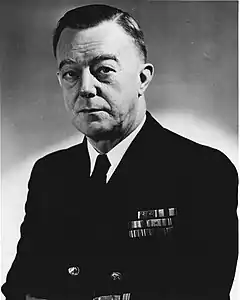Thorvald A. Solberg | |
|---|---|
 Rear Admiral Thorvald A. Solberg | |
| Born | 17 February 1894 Mason, Wisconsin |
| Died | 16 May 1964 (aged 70) Philadelphia, Pennsylvania |
| Buried | |
| Allegiance | |
| Service/ | |
| Years of service | 1916–1951 |
| Rank | |
| Service number | O-2552 |
| Commands held | Office of Naval Research |
| Battles/wars | World War I World War II |
| Awards | Legion of Merit (3) Order of the British Empire |
Rear Admiral Thorvald A. Solberg (17 February 1894 – 16 May 1964) was a senior officer in the United States Navy, and the Chief of the Office of Naval Research from 1948 to 1951.
Biography
Thorvald A. Solberg was born in Mason, Wisconsin, on 17 February 1894,[1] the son of Norwegian immigrants Thomas and Martha Solberg.[2] In 1905, the family moved to Sandpoint, Idaho, where he graduated from Sandpoint High School in 1911.[3]
Solberg was appointed to the United States Naval Academy in Annapolis, Maryland by Senator William Borah of Idaho, and was commissioned in the United States Navy as an ensign on graduation in 1916.[3] During World War I he served on board the cruiser USS Tacoma.[1]
Solberg studied electrical engineering at the Naval Postgraduate School,[3] and then attended Columbia University, receiving a Master of Science (M.S.) degree in 1924.[1] In 1931 and 1932 he worked on the development of a boiler compound to prevent the buildup of limescale in ships' boilers. This was approved by the Bureau of Engineering in its 1933 "Standard Navy Boiler Compound Specifications".[4]
During World War II, he was an engineering officer on the staff of the Commander, Battle Force from July 1939 to April 1941. He then went to London as a naval observer. He returned to the United States in March 1944, and served with the Bureau of Ships until October 1946. He was promoted to the rank of rear admiral in 1945, with his seniority backdated to December 1942.[1]
During Operation Crossroads in 1946, Solberg was responsible for preparing the target fleet.[5] As head of the Bureau of Ships' Research and Standards Branch, he was also appointed to the Military Liaison Committee of the Atomic Energy Commission in November 1946.[6] He became the Chief of the Office of Naval Research in 1948, a position he held until he retired in 1951.[3]
Solberg was thrice awarded the Legion of Merit.[3] In 1947, Solberg Inlet in Antarctica was named after him by the Ronne Antarctic Research Expedition (RARE) in recognition of the assistance given to the expedition by Solberg and the Office of Naval Research.[7] He was also appointed Honorary Knight Commander of the Order of the British Empire for his service for the allied cause.[8]
He was forced to retire in 1951 after reaching 35 years of service.[9] He died on 16 March 1964,[1] and was buried in Arlington National Cemetery.[10]
Notes
- 1 2 3 4 5 Ancell & Miller 1996, p. 615.
- ↑ "1900 United States Federal Census for Thorval A Solberg". Ancestry.com. Retrieved 14 February 2014.
- 1 2 3 4 5 "Admiral Solberg, Former Resident, Called by Death". 4 June 1964. Retrieved 14 February 2014.
- ↑ Carlisle 1998, p. 100.
- ↑ Christman 1998, p. 220.
- ↑ "Army-Navy Group to Work With Atomic Energy Commission Named". The Southeast Missourian. 4 November 1946. Retrieved 14 February 2014.
- ↑ "Name Details: Solberg Inlet". Australian Antarctic Data Centre. Retrieved 13 February 2013.
- ↑ "Britain decorates 65 U.S. Officers, The New York Times, Thursday, July 22, 1948, page 5". timesmachine.nytimes.com. New York Times Websites. Retrieved 19 June 2018.
- ↑ Golden, William T. (15 January 1951). "Conversation with Rear Admiral T. Solberg, Director, Office of Naval Research" (PDF). American Association for the Advancement of Science. Retrieved 14 February 2014.
- ↑ "Solberg, Thorvald A". ANC Explorer. Retrieved 19 July 2021.
References
- Ancell, R. Manning; Miller, Christine (1996). The Biographical Dictionary of World War II Generals and Flag Officers: The US Armed Forces. Westport, Connecticut: Greenwood Press. ISBN 0-313-29546-8. OCLC 33862161.
- Carlisle, Rodney P. (1998). Where the fleet begins: a history of the David Taylor Research Center, 1898-1998. Washington, D.C.: United States Naval Historical Center. ISBN 0-160-49442-7. OCLC 39229697.
- Christman, Albert B. (1998). Target Hiroshima: Deak Parsons and the Creation of the Atomic Bomb. Annapolis, Maryland: Naval Institute Press. ISBN 1-55750-120-3. OCLC 38257982.